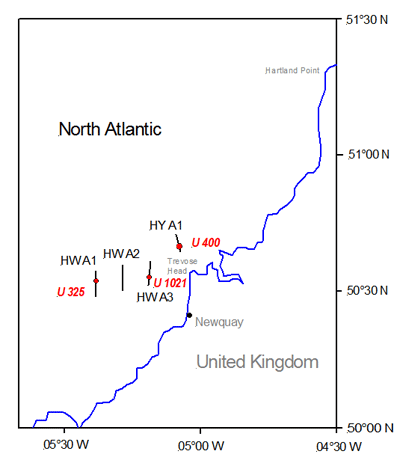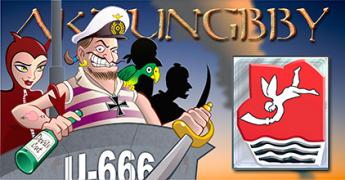|
Gefallen Engel U-666
Join Date: Jul 2013
Location: On a tilted, overheated, overpopulated spinning mudball on Collision course with Andromeda Galaxy
Posts: 27,871
Downloads: 22
Uploads: 0
|

Quote:
Originally Posted by StefanWtal

After ca. 75 years my grandfather died on U-400.
He served as a "Bootsmannsmaat" on this boot.
Rgds,
Stefan Maas
|
YOUR GRANDFATHER PERISHED IN ONE OF THE SNEAKIEST OPERATIONS IN THE BATTLE FOR THE ATLANTIC...OR, IN THIS CASE PROPERLY THE SEVERN SEA OFF THE CORNISH COAST. IT WAS A SECRET FOR OVER 60 YEARS: http://www.cix.co.uk/~klockstone/uboat.htm
Quote:
"U400 - Originally credited to the depth charges of HMS Nyasaland, a Colony-class frigate, on December 17, 1944, off the south coast of Ireland. Now discovered, definitely mined, in the swept channel area off Padstow, sometime in December 1944. Nyasaland's target off south Ireland is now considered to have been U772, originally credited to Sunderland aircraft attack, but she now seems to have survived that attack and is now changed to that ship's credit off Ireland. Divers have uncovered the wrecks of three Second World War German U-boats off the Cornish coast, which have shed light on a British operation that has remained secret for more than 60 years.
Historians were amazed at the discovery of the catastrophically damaged U-boats which are lying in close proximity to each other seven miles off Newquay, because no U-boats had ever been recorded being lost there previously.
After extensive research it was revealed they had been the victims of a secret minefield laid especially to trap such vessels after the British intercepted a radio message from a U-boat commander. His boat had sunk a British destroyer after discovering a gap in the minefield between Cornwall and Ireland to allow supply ships in to Cardiff and Bristol.
He radioed the news back to Germany, but the message was deciphered by British intelligence at Bletchley Park. As a result the British laid deep mines designed to allow surface ships through but trap U-boats.
Historians were unaware of the secret U-boat death trap until the Government de-classified wartime documents recently. And now the discovery of the three wrecked U-boats off Cornwall has shown just how successful it was.
Naval historian Eric Grove said the fate of the U-325, U-400, and U-1021, which disappeared in late 1944 and early 1945 was revealing.
"This shows the deep trap minefield was far more successful in killing U-boats than first thought," he said. "It was only recently the Government revealed the existence of this deep water minefield and the presence of these wrecked U-boats shows how effective it was. The U-boat crews were under orders to patrol coastal waters hunting Allied shipping at the end of the war because the Atlantic campaign was over. Admiralty records show two of the three U-boats in question were thought to have been sunk by depth charge in the Bristol Channel. This new research shows that was wrong and they actually struck mines off Cornwall."
|
ALSO: https://uboat.net/articles/69.html
Quote:
However, following a promising situation report from the English Channel area by U 978, U 680 was redirected to the latter area on 2 December 1944. Only two days latter U 400 received the order to patrol off the Cornish coast as a replacement for U 680.
Through Ultra decrypts the British Admiralty was well and timely informed about all of the above-mentioned German situation reports and operational intentions. According to the Naval Staff History of British Mining Operations 1939-1945 Vol. I, the Admiralty issued a policy signal to CinC Western Approaches on 15 November 1944 stating that "further consideration has been given to the relative importance of anti-U-boat minefields in the NW and SW Approaches. Routing of ocean convoys south of Ireland not only renders this the more attractive area but U-boats' course of action can to some extent be anticipated. In the NW Approaches, mine-laying operations must follow rather than anticipate U-boat activities. […] Consider therefore as a matter of policy that mine-laying operations should be concentrated in the SW Approaches”. In pursuance of their stated policy and to meet the expected concentration of U-boats in the SW Approaches, the Admiralty ordered, by signal on 25 November 1944, that the minelayer HMS Apollo should lay three lines of deep mines off Trevose Head, before cleaning boilers and making good defects at Plymouth. The operation “HW” was to be conducted by C in C, Plymouth, and it was forecast that the minelayer HMS Plover would be available, at the beginning of December, to continue these fields along the swept channel between Trevose Head and Hartland point in operation “HY”. Between 29 November 1944 and 3 January 1945, the two minelayers laid over 1,200 Mk XVII moored mines in 11 ‘deep fields' across the coastal convoy route along the north coast of Cornwall. Moored mines were used because ground mines sensitive enough to catch slow-moving U-boats would also have posed a threat to Allied surface ships. It will be noted that these mines were placed exactly within the area U-boat Command had explicitly declared mine-free in its amendment to the Bristol Channel situation report on 18 November 1944. Being aware of this advice, the British Admiralty set a well-placed mine-trap.
Comparison of the exact geographical coordinates for the individual mine fields with the nautical positions of the three U-boat wrecks revealed that each of the wreck positions are a nearly a perfect match with one of the above mentioned minefields:.... Wreck No 1 is fitted with the old Type 1 folding schnorkel installation with half-height pressure flange connection to the diesel air intake tube along the port side of the conning-tower casing in combination with a ring-float schnorkel valve with Wesch-type anti-radar coating on the circular stem tube between the exhaust outlet and the ring-float head. No anti-radar coating is found on the drum-shaped ring-float head. The circular foundation plate for a deck gun originally installed on type VIIC boats is clearly in place in front of the conning-tower, forward to the rectangular hatch covering the former ready-for-use ammunition space. In addition, the gun mount of the 3.7 cm AA gun now lying on top of the wreck closely resembles the late-war Type LM43U gun mount. U 400 was fitted with one of the first such mounts for frontline testing. While U 1021 is known to have been fitted with a ball-float schnorkel head, U 325 is recorded to have carried the Jaumann-type anti-radar coating on its ring-float type schnorkel head. In addition, U 325 was never fitted with the deck gun foundation plate. Based on this evidence, it is concluded that the identity of the wreck No 1 should be that of U 400. According U-boat Command’s daily plot, U 400 was expected to arrive in its operational area on or shortly after 14 December 1944. Thus it is entirely plausible that U 400 met its end only days after laying of the new A/S minefield Wreck No 1 is fitted with the old Type 1 folding schnorkel installation with half-height pressure flange connection to the diesel air intake tube along the port side of the conning-tower casing in combination with a ring-float schnorkel valve with Wesch-type anti-radar coating on the circular stem tube between the exhaust outlet and the ring-float head. No anti-radar coating is found on the drum-shaped ring-float head. The circular foundation plate for a deck gun originally installed on type VIIC boats is clearly in place in front of the conning-tower, forward to the rectangular hatch covering the former ready-for-use ammunition space. In addition, the gun mount of the 3.7 cm AA gun now lying on top of the wreck closely resembles the late-war Type LM43U gun mount. U 400 was fitted with one of the first such mounts for frontline testing. While U 1021 is known to have been fitted with a ball-float schnorkel head, U 325 is recorded to have carried the Jaumann-type anti-radar coating on its ring-float type schnorkel head. In addition, U 325 was never fitted with the deck gun foundation plate. Based on this evidence, it is concluded that the identity of the wreck No 1 should be that of U 400. According U-boat Command’s daily plot, U 400 was expected to arrive in its operational area on or shortly after 14 December 1944. Thus it is entirely plausible that U 400 met its end only days after laying of the new A/S minefield
|
__________________

"Only two things are infinite; The Universe and human squirrelyness; and I'm not too sure about the Universe"
|